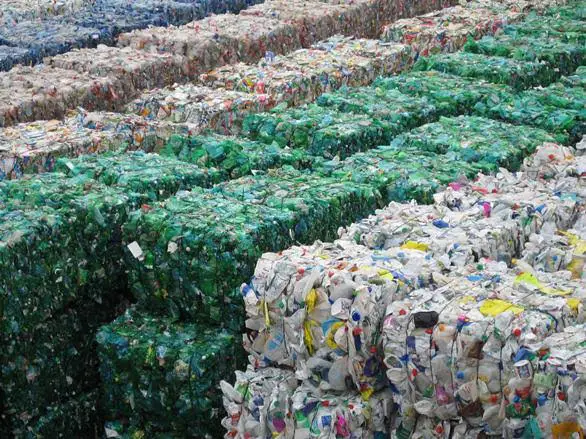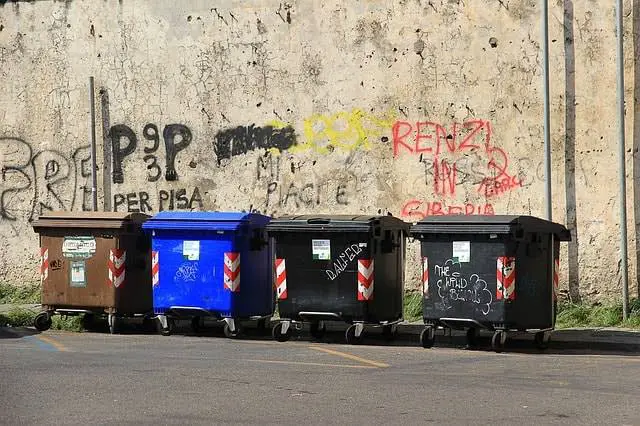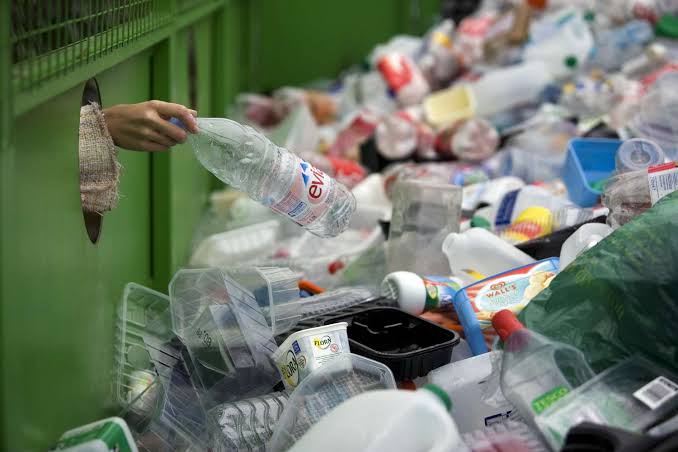Wastes into Recycling Bins; Plastic Containers (HDPE) Wastes can be transformed into Recycling Bins. When we have lots of plastic containers, instead of throwing them away, we can turn them into something useful. Recycling bins are important because they help us collect recyclable materials like paper, plastic, and glass. By converting plastic containers into recycling bins, we can contribute to keeping our environment clean and reducing the amount of waste that ends up in landfills or oceans.
To convert plastic containers into recycling bins, we need to gather the materials first. We will need empty plastic containers made from HDPE, which is a type of plastic that is commonly used for things like milk jugs, detergent bottles, and shampoo containers. HDPE is a good choice for recycling bins because it is strong and durable.
Once we have collected enough plastic containers, we can start the transformation process. First, we need to clean the containers thoroughly to remove any leftover residue or labels. Then, we can use scissors or a utility knife to cut off the tops of the containers to create an opening where recyclable materials can be deposited.
Next, we need to decorate the containers to make them look like recycling bins. We can use paint, stickers, or markers to add labels and symbols indicating what materials should be placed inside each bin. For example, we can use the recycling symbol with arrows pointing in a circle to represent recycling.
After decorating the bins, we need to make them easy to use. We can attach handles or straps to the sides of the bins to make them easy to carry. We can also add lids to the bins to keep the recyclable materials contained and prevent them from blowing away in the wind.
Once our recycling bins are complete, we can start using them to collect recyclable materials. We can place them in convenient locations around our home, school, or community so that people can easily dispose of their recyclables. By encouraging others to use our homemade recycling bins, we can help promote recycling and reduce the amount of waste that ends up in our environment.
Converting plastic containers (HDPE) wastes into recycling bins is a simple and effective way to promote recycling and reduce waste. By repurposing materials that would otherwise be thrown away, we can create useful tools for collecting recyclable materials and help protect our planet for future generations.
Read Also: How to Convert Plastic Containers (PVC) Wastes into Packaging Materials
Types of Recyclable Plastic Containers (HDPE) Wastes and their Uses

Recyclable plastic containers made from HDPE (High-Density Polyethylene) come in various types, each serving different purposes. Here are some common types of HDPE plastic containers and their potential uses:
1. Milk Jugs: Milk jugs are one of the most recognizable HDPE plastic containers. After being cleaned and sanitized, they can be repurposed into watering cans for gardening. Simply cut off the top, poke holes in the lid, and attach a handle for easy pouring.
2. Detergent Bottles: Detergent bottles are often made from HDPE and can be reused in several ways. They can be transformed into storage containers for laundry detergent pods or repurposed as scoop holders for pet food or birdseed.
3. Shampoo Bottles: Empty shampoo bottles can be given a second life as organizers for small items like hair accessories, makeup brushes, or office supplies. Cut off the top and use the bottom portion to store and organize your belongings neatly.
4. Condiment Bottles: HDPE condiment bottles, such as those used for ketchup or mustard, can be washed thoroughly and repurposed as squeeze bottles for homemade sauces or dressings. They can also be used to store and dispense cooking oils or vinegars.
5. Yogurt Tubs: Yogurt tubs made from HDPE can be reused in various ways around the house. They make excellent storage containers for leftovers or meal prep ingredients. Additionally, they can be used as plant pots for starting seeds or propagating cuttings.
6. Ice Cream Tubs: After enjoying your favorite ice cream, clean out the tub and use it to organize small items in your pantry or fridge. Ice cream tubs can also be repurposed as containers for storing craft supplies, such as beads, buttons, or small toys.
7. Water Bottles: HDPE water bottles can be refilled and reused multiple times before being repurposed. They can serve as portable water containers for hiking or camping trips or be transformed into bird feeders by cutting out openings for birds to access the seeds.
8. Produce Containers: Plastic containers used for packaging fruits and vegetables can be repurposed as storage bins for organizing household items like batteries, lightbulbs, or sewing supplies. They can also be used as makeshift planters for growing herbs or small indoor plants.
By creatively repurposing HDPE plastic containers, we can extend their lifespan and reduce the amount of waste that ends up in landfills. With a little imagination and effort, these versatile containers can be transformed into useful items for various purposes around the home and garden.
How to Convert Plastic Containers (HDPE) Wastes into Recycling Bins

Converting plastic containers (HDPE) wastes into recycling bins is a simple and rewarding DIY project. Here’s a step-by-step guide on how to do it:
1. Gather Materials: Collect empty plastic containers made from HDPE, such as milk jugs, detergent bottles, or shampoo containers. Make sure to choose containers that are clean and free of any leftover residue or labels.
2. Prepare the Containers: Thoroughly clean the plastic containers with soap and water to remove any dirt or grime. Remove any labels or stickers from the containers, as these can interfere with the recycling bin’s appearance.
3. Cut Openings: Use scissors or a utility knife to cut off the tops of the containers to create an opening where recyclable materials can be deposited. The size of the opening will depend on the type and size of the container, but aim for a large enough opening to easily accommodate recyclable items like paper, plastic, and glass.
4. Decorate the Bins: Get creative and decorate the plastic containers to make them look like recycling bins. You can use paint, stickers, or markers to add labels and symbols indicating what materials should be placed inside each bin. For example, use the recycling symbol with arrows pointing in a circle to represent recycling.
5. Add Handles or Straps: Attach handles or straps to the sides of the bins to make them easy to carry and transport. This will encourage people to use the bins and make it convenient for them to dispose of their recyclables.
6. Add Lids (Optional): Consider adding lids to the bins to keep the recyclable materials contained and prevent them from blowing away in the wind. Lids can also help to reduce odors and keep pests out of the bins.
7. Place the Bins: Once your recycling bins are complete, place them in convenient locations around your home, school, or community. Choose areas where people are likely to generate recyclable materials, such as near the kitchen or in common areas.
8. Encourage Use: Encourage others to use your homemade recycling bins by spreading awareness and educating them about the importance of recycling. You can also lead by example and demonstrate how easy and convenient it is to recycle using your DIY bins.
By following these steps, you can easily convert plastic containers (HDPE) wastes into functional and attractive recycling bins. Not only will you be reducing waste and promoting recycling, but you’ll also be contributing to a cleaner and more sustainable environment.
The Benefits of Converting Plastic Containers (HDPE) Wastes into Recycling Bins
Converting plastic containers (HDPE) wastes into recycling bins offers numerous benefits for both individuals and the environment:
1. Reduces Waste: By repurposing plastic containers into recycling bins, we reduce the amount of waste that ends up in landfills or pollutes our environment. Instead of disposing of these containers, we give them a new purpose and extend their lifespan.
2. Promotes Recycling: Recycling bins provide a designated place for people to dispose of recyclable materials like paper, plastic, and glass. By making recycling more convenient and accessible, we encourage people to participate in recycling programs and divert valuable materials from the waste stream.
3. Saves Resources: Recycling bins help conserve natural resources by promoting the reuse and recycling of materials like plastic and paper. When these materials are recycled, they can be processed and used to manufacture new products, reducing the need for virgin materials.
4. Creates Awareness: By displaying homemade recycling bins in visible locations, we raise awareness about the importance of recycling and environmental conservation. People are more likely to engage in recycling when they see tangible reminders and opportunities to participate.
5. Encourages Responsibility: Providing recycling bins encourages individuals to take responsibility for their waste and make conscious choices about how they dispose of materials. It empowers people to contribute to positive environmental change and become more environmentally conscious citizens.
6. Engages Communities: Setting up homemade recycling bins can foster a sense of community involvement and collaboration. It brings people together around a common goal of environmental stewardship and encourages teamwork and cooperation.
7. Cost-Effective Solution: Converting plastic containers into recycling bins is a cost-effective solution compared to purchasing new bins. It repurposes materials that would otherwise be discarded and saves money on purchasing new bins for recycling programs or initiatives.
8. Reduces Pollution: Properly disposing of recyclable materials in designated bins helps prevent pollution of the air, land, and waterways. It reduces litter and keeps our communities cleaner and more aesthetically pleasing.
Overall, converting plastic containers (HDPE) wastes into recycling bins is a simple yet effective way to promote recycling, reduce waste, and contribute to a more sustainable future. By taking small actions like this, we can make a big difference in protecting the environment for generations to come.
Read Also: How to Convert Plastic Containers (HDPE) Wastes into Detergent Bottles
The Uses and Benefits of Recycled Recycling Bins

The uses and benefits of recycled recycling bins are multifaceted and contribute to environmental sustainability and community well-being in various ways:
Uses:
1. Collection of Recyclables: Recycled recycling bins serve their primary purpose of collecting recyclable materials such as paper, plastic, glass, and metal. They provide a designated place for individuals to dispose of these materials, making recycling more convenient and accessible.
2. Sorting and Organization: Recycling bins help in sorting and organizing recyclable materials, making it easier for waste management facilities to process them efficiently. Different bins for different types of materials streamline the recycling process and ensure that materials are properly sorted for recycling.
3. Promotion of Recycling: The presence of recycling bins serves as a visual reminder and encourages people to engage in recycling practices. By providing easy access to recycling bins in homes, schools, workplaces, and public spaces, recycling rates can increase, leading to a more sustainable waste management system.
4. Education and Awareness: Recycling bins often feature labels and signage that educate users about the types of materials that can be recycled and the importance of recycling. This helps raise awareness about environmental issues and encourages individuals to adopt more sustainable behaviors.
5. Community Engagement: Recycling bins can be used as a tool for community engagement and participation in environmental initiatives. Community-led recycling programs and events, such as neighborhood clean-ups and recycling drives, can help foster a sense of collective responsibility and stewardship for the environment.
Benefits:
1. Conservation of Resources: Recycling bins facilitate the recovery and reuse of valuable resources such as paper, plastic, and metal, reducing the need for virgin materials. This conserves natural resources, reduces energy consumption, and minimizes the environmental impact of resource extraction and manufacturing processes.
2. Reduction of Waste: By diverting recyclable materials from the waste stream, recycling bins help reduce the amount of waste sent to landfills or incinerators. This helps mitigate environmental pollution and minimizes the greenhouse gas emissions associated with waste disposal.
3. Energy Savings: Recycling bins contribute to energy savings by reducing the energy required to manufacture new products from raw materials. Recycling materials like aluminum, glass, and plastic consumes less energy than producing them from scratch, resulting in lower carbon emissions and environmental footprint.
4. Job Creation: The recycling industry creates employment opportunities in collection, sorting, processing, and recycling operations. By supporting recycling initiatives and using recycled products, communities can stimulate economic growth and create green jobs in their localities.
5. Improvement of Public Health: Recycling bins help prevent littering and illegal dumping of waste, which can have detrimental effects on public health and safety. Proper waste management practices, including recycling, contribute to cleaner and healthier environments for communities to live and thrive in.
Recycled recycling bins play a vital role in promoting sustainable waste management practices, conserving resources, reducing waste, and fostering community engagement. By maximizing the use of recycled materials and promoting recycling initiatives, we can work towards building a more environmentally sustainable and resilient future.
The Challenges of Converting Plastic Containers (HDPE) Wastes into Recycling Bins and their Solutions
Converting plastic containers (HDPE) wastes into recycling bins presents several challenges, but with creativity and perseverance, these obstacles can be overcome. Here are some common challenges and potential solutions:
Challenges:
1. Limited Availability of Suitable Containers: Finding a sufficient quantity of clean and suitable HDPE plastic containers can be challenging, especially in areas where recycling infrastructure is lacking or where single-use plastics are prevalent.
2. Cleaning and Preparation: Thoroughly cleaning and preparing the plastic containers for conversion into recycling bins can be time-consuming and labor-intensive. Removing labels, adhesive residues, and contaminants requires effort and resources.
3. Durability and Longevity: Ensuring that the converted recycling bins are durable and long-lasting can be a challenge, particularly if the original plastic containers are of low quality or have been weakened by exposure to sunlight or harsh environmental conditions.
4. Aesthetics and Appeal: Creating recycling bins that are visually appealing and encourage use can be a challenge, especially if the containers have limited design options or if the conversion process results in rough or unattractive finishes.
5. Community Acceptance and Participation: Garnering support and participation from the community for homemade recycling bins may pose challenges, particularly if there is resistance to change or skepticism about the effectiveness of DIY recycling initiatives.
Solutions:
1. Community Collaboration and Outreach: Work with local businesses, schools, and community organizations to collect HDPE plastic containers. Organize recycling drives or community clean-up events to gather materials and raise awareness about the project.
2. Invest in Cleaning Equipment: Invest in cleaning equipment such as scrub brushes, detergents, and hot water to streamline the cleaning and preparation process. Consider enlisting volunteers or organizing work parties to help with cleaning and preparing the containers.
3. Reinforcement and Reinforcement: Strengthen the plastic containers by reinforcing weak spots or adding additional support structures as needed. Consider using reinforcement materials such as metal brackets, wooden frames, or fiberglass coatings to enhance durability and longevity.
4. Creative Design and Decoration: Get creative with design and decoration to make the recycling bins more visually appealing. Use colorful paints, decals, or stencils to add labels, symbols, or messages that promote recycling and environmental awareness.
5. Education and Engagement: Educate the community about the benefits of homemade recycling bins and the importance of recycling. Host workshops, presentations, or demonstrations to showcase the conversion process and encourage participation. Provide incentives or rewards for community members who actively support the initiative.
By addressing these challenges proactively and collaboratively, converting plastic containers (HDPE) wastes into recycling bins can become a successful and rewarding endeavor. With determination and community support, homemade recycling bins can make a meaningful contribution to waste reduction and environmental sustainability.
Frequently Asked Questions (FAQs) About How to Convert Plastic Containers (HDPE) Wastes into Recycling Bins
1. Q: What types of plastic containers can be used to make recycling bins?
A: Various types of plastic containers made from HDPE (High-Density Polyethylene) can be used, including milk jugs, detergent bottles, shampoo containers, condiment bottles, yogurt tubs, ice cream tubs, water bottles, and produce containers.
2. Q: How do I clean plastic containers before converting them into recycling bins?
A: To clean plastic containers, rinse them thoroughly with soap and water to remove any residue or labels. For stubborn residue, you can use a mild detergent or baking soda paste and scrub with a brush or sponge. Rinse the containers well and allow them to dry completely before proceeding with the conversion process.
3. Q: Do I need any special tools or equipment to convert plastic containers into recycling bins?
A: Basic tools such as scissors or a utility knife are typically sufficient for cutting openings in the containers. You may also need paint, stickers, markers, or other decorating materials to customize the bins. Additionally, consider using handles, straps, or lids to enhance functionality.
4. Q: Can I recycle the leftover plastic scraps from cutting the containers?
A: Yes, leftover plastic scraps can typically be recycled along with other plastic materials. Check with your local recycling facility to confirm their specific guidelines for recycling plastic scraps.
5. Q: How can I encourage others to use homemade recycling bins?
A: You can encourage others to use homemade recycling bins by raising awareness about the benefits of recycling and the importance of waste reduction. Lead by example and demonstrate how easy and convenient it is to recycle using the homemade bins. Consider organizing educational workshops or events to engage and inspire others to participate.
6. Q: Can I use the recycling bins for other purposes besides recycling?
A: While the primary purpose of the bins is for recycling, they can also be repurposed for other storage or organizational needs. For example, you can use them to store gardening supplies, pet food, or household items. Just make sure to clean the bins thoroughly before repurposing them for different uses.
Read Also: How Do Honey Bees Make Honey

